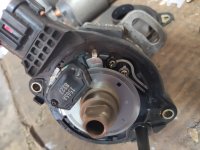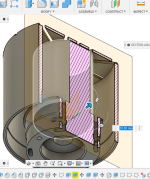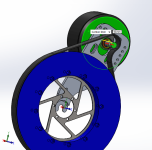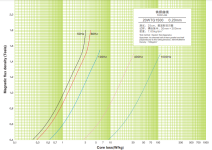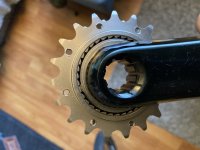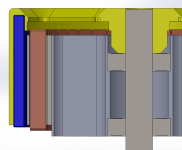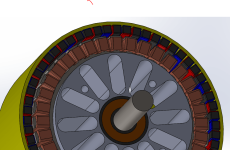Hummina Shadeeba said:
will core losses increase with higher current even before saturation? makes sense but never see it mentioned and seems skipped in rc plane calculators or simulators
I think not necessarily, since the permanent magnets provide the most significant field at lower current, and the current induced field just leads the magnet induced field so overall, the field strength doesn't increase (I think...) Or maybe it increases with
(current induced stator field^2) + (magnet induced stator field)^2)^0.5
Hummina Shadeeba said:
in my looking at the benefits of greater poles it doesnt increase torque other than with the many poles the magnets are then smaller so you can increase your airgap diameter by maybe a millimeter with the smaller magnets or something but that's it. cheaper, lighter, and better control though
I am fairly sure (but not certain) the (possible, limited by saturation) torque does increase with more poles.
Hummina Shadeeba said:
seems awfully high flux density with the kawasaki steel and it doesnt even show any saturation effects at 1.6T. or am i wrong? it looks like it even improves from 1.6 to 1.8T which id think was way into saturation.
Baosteel, and I have no idea.
I guess once saturated, the incremental losses drop off since the H field can greatly increase? I kind of thought it would be the other way round, but my understanding is in flux.
EDIT:
A few hours after writing this, and reading through https://www.et.aau.dk/digitalAssets/292/292916_unified-torque-expressions-of-ac-machines---web-version.pdf
I retract my second statement that max torque possible increases with poles.
After more thinking, the assumption and experiment I based this on (lining up 2 large magnets vs 8 small magnets of the same total mass and observing the shear force was larger on the small ones) and that torque is proportional to rate of change of flux linkage (I think it is, but this breaks down at saturation, which is what we are discussing) has a flaw - I was assuming same thickness of magnets and same air return path.
If you add large lumps of iron to the equation, everything changes. The flux can link much more effectively from pole to pole, and the overall integral of rate of change of flux around the circumference of the stator remains the same.
So my revised "statement" (still with less than complete certainty) is that torque will remain the same for a given airgap, regardless of poles, PROVIDED there is sufficient iron to link the flux back to the opposite pole.
So for a 1 pole pair motor, you can get the same torque as a 2,4.....2000 pole pair motor, but the required thickness of iron to relay the magnetic flux will increase in inverse proportion to the number of pole pairs and so the mass of the motor will increase. Similarly, the limiting factor being the iron losses to frequency and copper fill, the power of the motor will increase dramatically with pole pair decrease... but there will be a pile more iron.
Overall, instantaneous power capability scales with weight, and instantaneous torque scales with airgap.
So for our ebike things, we could probably express the weight of the motor required based on the power (speed) we want to get to, and the air gap radius based on our possible gear ratio we have.
Apply practicality... and we have a set of workable parameters.
My first stator (24n) and the one I found last night (36n) will produce the same torque. The second one weighs substantially less (about 2/3 as much) so will produce about 2/3 as much power before the iron losses become equal, an will go 2/3 as fast...
A lot of thinking and logic to come to the same conclusion as always... There is no free lunch, you need more mass of motor to go faster, you can only eliminate the wastes and make marginal improvements. Who'd have thought it...


